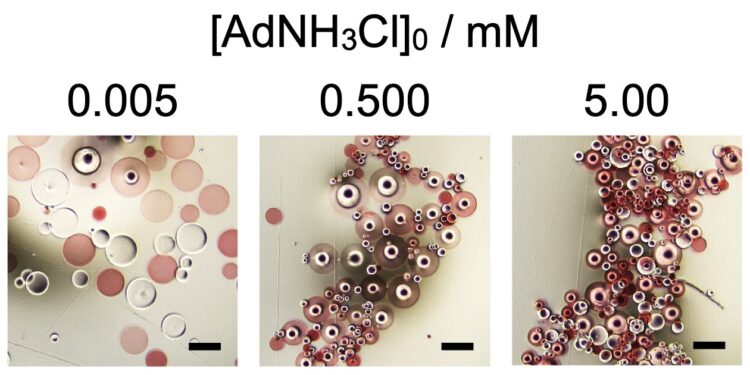Typical examples of optical micrograms for assemblies formed by βCD(16,2)-SAP and Ad(15,1)-SAP microparticles in the presence of varying concentrations of AdNH3Cl ((AdNH3Cl)0). Bars indicate 100 μm. Credit: 2024 Hashidzume et al., Additive-assisted macroscopic self-assembly and shape control of assemblies based on host-guest interaction, Scientific Reports
If you’ve ever opened an IKEA box and wished that the pieces inside could spontaneously fuse together to form a table or chair, then a simple virus might have a thing or two to teach you. The self-assembly of complex molecules is essential for a wide range of biological structures, including proteins, cell membranes, or even entire viruses. Supramolecular chemistry is a field of study that attempts to build large molecules from a discrete number of smaller building blocks.
By altering the attractive force between different polymers, complexes can be built on demand, leading to the development of “smart materials” that respond to changes in their environment, such as the addition of a new chemical. However, many aspects of supramolecular chemistry remain poorly understood.
However, in a study published in Scientific reportsResearchers at Osaka University have shown how additives can promote the self-assembly of spherical microparticles made of the superabsorbent polymer, sodium polyacrylate, as well as control the macroscopic shape of the resulting assemblies.
Some polymer molecules were functionalized with a specific chemical, β-cyclodextrin (βCD), and others with adamantane (Ad) residues. However, the microparticles did not assemble until reaching a critical threshold concentration of the additive 1-adamantanamine hydrochloride (AdNH3Cl) was introduced.
The researchers took inspiration from biological proteins, which are made up of long chains of smaller units called amino acids. Certain attractions or repulsions between amino acids, including hydrogen bonds, electrostatic interactions, or hydrophobic interactions, can control the folded shape of the resulting protein. Similar effects can occur with other large biomolecules, including DNA, polysaccharides, and lipids.
-
Conceptual illustration of the formation of assemblies from βCD(x)-SAP and Ad(y)-SAP microparticles assisted by the addition of AdNH3Cl. Credit: 2024 Hashidzume et al., Additive-assisted macroscopic self-assembly and shape control of assemblies based on host-guest interaction, Scientific Reports
-
The aspect ratio (a/b) for assemblies formed by βCD(26,7)-SAP microparticles and unmodified SAP in the presence of varying concentrations of AdNH3Cl ((AdNH3Cl)0). Credit: 2024 Hashidzume et al., Additive-assisted macroscopic self-assembly and shape control of assemblies based on host-guest interaction, Scientific Reports
“In a sense, all living organisms are just collections of supramolecular polymers with sophisticated functions,” says Akihito Hashidzume, lead author of the study.
The team analyzed the behavior of macroscopic assembly of spherical microparticles and found that the resulting shape, whether more spherical or elongated, could be controlled depending on the AdNH3Cl concentration. This suggests that stimuli, such as heat and force, can be used to control the shape of the assemblies.
“The results of this study could help us understand the origin of various forms of organisms,” says Akira Harada, lead author of the study. This research could also contribute to future work on controlling macroscopic assemblies based on microscopic interactions, as well as new active materials that change depending on their situation.
More information:
Akihito Hashidzume et al., Additive-assisted macroscopic self-assembly and shape control of assemblies based on host-guest interaction, Scientific reports (2024). DOI: 10.1038/s41598-024-71649-z
Provided by Osaka University
Quote: Smart Supramolecular Assemblies: Researchers Show How Additives Promote Self-Assembly of Spherical Microparticles (2024, September 12) retrieved September 12, 2024 from
This document is subject to copyright. Apart from any fair dealing for the purpose of private study or research, no part may be reproduced without written permission. The content is provided for informational purposes only.



